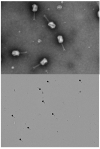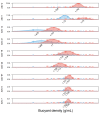Bacterial Consumption of T4 Phages
- PMID: 34576747
- PMCID: PMC8472381
- DOI: 10.3390/microorganisms9091852
Bacterial Consumption of T4 Phages
Abstract
The bacterial consumption of viruses not been reported on as of yet even though bacteria feed on almost anything. Viruses are widely distributed but have no acknowledged active biocontrol. Viral biomass undoubtedly reintegrates trophic cycles; however, the mechanisms of this phase still remain unknown. 13C-labelled T4 phages monitor the increase of the density of the bacterial DNA concomitant with the decrease of plaque forming units. We used 12C T4 phages as a control. T4 phage disappearance in wastewater sludge was found to occur mainly through predation by Aeromonadacea. Phage consumption also favours significant in situ bacterial growth. Furthermore, an isolated strain of Aeromonas was observed to grow on T4 phages as sole the source of carbon, nitrogen, and phosphorus. Bacterial species are capable of consuming bacteriophages in situ, which is likely a widespread and underestimated type of biocontrol. This assay is anticipated as a starting point for harnessing the bacterial potential in limiting the diffusion of harmful viruses within environments such as in the gut or in water.
Keywords: Aeromonas; bacteriophage; stable isotope probing.
Conflict of interest statement
The authors declare no conflict of interest. The funders had no role in the design of the study; in the collection, analyses, or interpretation of data; in the writing of the manuscript, or in the decision to publish the results.
Figures






References
LinkOut - more resources
Full Text Sources
Molecular Biology Databases

